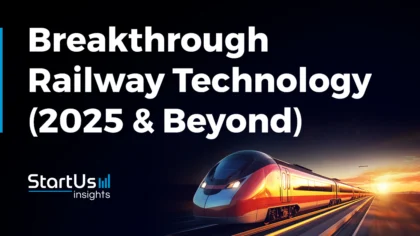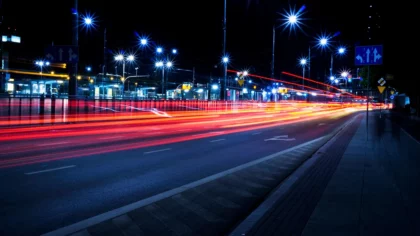Our Innovation Analysts recently looked into emerging technologies and up-and-coming startups working on solutions for railroads. As there is a large number of startups working on a wide variety of solutions, we want to share our insights with you. This time, we are taking a look at 5 promising Smart Railway solutions.
Heat Map: 5 Top Smart Railway Solutions
For our 5 top picks, we used a data-driven startup scouting approach to identify the most relevant solutions globally. The Global Startup Heat Map below highlights 5 interesting examples out of 630 relevant solutions. Depending on your specific needs, your top picks might look entirely different.
Primerail Infralabs – Design Innovations
Growing populations and rising congestion in urban centers have made traditional railway infrastructure, which takes up a lot of space, difficult to implement. In densely populated urban locations, constructing new metro rail lines costs too much in terms of land acquisition, inspection and leveling, and eventual construction. These projects also take several years to complete, leaving urban cities in a state of congestion for a prolonged period.
Indian startup Primerail Infralabs designs and develops novel urban transit solutions. Apart from providing existing mainline railway, rapid transit, and urban transportation with services like surveys, inspections, and design, they also develop radical solutions. PSC Plinths and Biebus are two of their patent-pending systems that stand to benefit urban transportation by reducing the costs of laying tracks.
REDS – Safety & Efficiency Improvements
Energy efficiency has been a subject of focus for many industries that use relatively old technologies as they look to improve their systems to utilize less energy. From air conditioners and refrigerators to trains and other infrastructure, companies are working to increase efficiency by using innovative software solutions that do not have a high-cost impact on operators and manufacturers.
Polish startup REDS develops software solutions to support railway operators to increase their safety, punctuality, and energy efficiency. Their Eco Driving system enhances the energy efficiency of all rail vehicles and helps optimize energy usage by automatically controlling the usage or suggesting actions like slowing down, speeding up, maintaining a constant speed or controlling heating and cooling.
SIA KTN – Electrical Railway Points Heating
Railway tracks traverse through all kinds of terrain and weather conditions to help connect different regions in a country or broader regions. Operating railways in such conditions pose a risk in terms of delays or more serious accidents. Whether it is the blowing sand in the desert or snow at higher altitudes, companies are developing innovative solutions to clear tracks and make train travel safer.
Latvian startup SIA KTN develops the Supervisory Control and Data Acquisition (SCADA) system for railway points heating. The fully automated point heating control system uses a series of models on climate and weather conditions. It can assess the best cleaning technique required, blowing snow off the track or electrical heating of ice on tracks. Their solution, which is still under testing and trials, allows real-time monitoring of tracks in regions that are hard to access.
Rail-Veyor – Intelligent Material Handling
The operating costs involved in loading, transporting, and unloading materials from mining and other industries continue to rise as road travel is often prone to delays, especially for hauling heavy materials. Traditional truck hauling is expensive and contributes to the significant carbon footprint of such industries. Advancements in freight technologies and the energy efficiency of railways have given rise to innovative solutions for material handling.
Canadian scale-up Rail-Veyor develops its eponymous bulk material hauling solution using railway tracks and intelligent design of tracks, loading and unloading systems, and freight locomotive. Once set up, operators benefit from reduced operating costs for overall material handling. Watch the video on their website to understand their solution in more detail!
Icer Rail – Friction Technology
Traditionally, railways have used cast iron brakes to keep trains immobile, slow them down and control acceleration during downhill tracks. Braking with iron, cement, other alloys, and metals generates extreme heat. This leads to wear and tear and increases the risk of accidents. Advancements in materials research and development allow for different materials to manufacture brakes, which removes the issues with current technologies.
Spanish scale-up Icer Rail, now a part of the Knorr-Bremse group, develops organic brake blocks covering a range of friction coefficients like LL (very low), L (low), K (high), and KK (very high) for locomotives, passenger coaches, freight wagons, and metros following international railway standards. They also replace cast iron blocks for freight and supplementary brake block for coaches, in compliance with the European Union for ‘rolling noise reduction’.
What About The Other 625 Smart Railway Solutions?
While we believe data is key to creating insights it can be easy to be overwhelmed by it. Our ambition is to create a comprehensive overview and provide actionable innovation intelligence for your Proof of Concept (PoC), partnership, or investment targets. The 5 smart railway solutions showcased above are promising examples out of 630 we analyzed for this article. To identify the most relevant solutions based on your specific criteria and collaboration strategy, get in touch.










